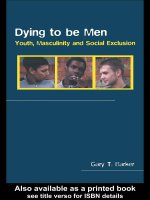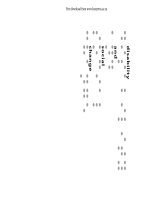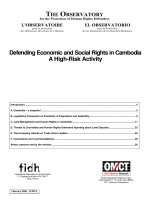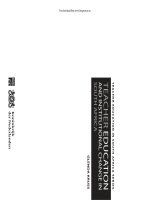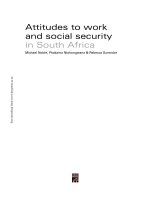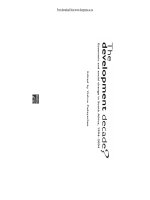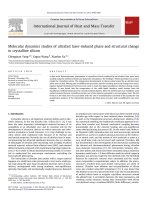Aspiring to be global language, mobilities, and social change in a tourism village in china
Bạn đang xem bản rút gọn của tài liệu. Xem và tải ngay bản đầy đủ của tài liệu tại đây (3.02 MB, 302 trang )
ASPIRING TO BE GLOBAL: LANGUAGE, MOBILITIES,
AND SOCIAL CHANGE IN A TOURISM VILLAGE IN CHINA
GAO SHUANG
(MA, BA)
A THESIS SUBMITTED
FOR THE JOINT DEGREE OF DOCTOR OF PHILOSOPHY
DEPARTMENT OF ENGLISH LANGAGE & LITERATURE
NATIONAL UNIVERSITY OF SINGAPORE
AND
CENTRE FOR LANGUAGE, DISCOURSE & COMMUNICATION
KING’S COLLEGE LONDON
2014 i
Acknowledgements
The completion of this thesis has benefited from many conversations with many
people over the years. I am all too aware that their kindness and generosity
deserve much more than a brief mentioning here, but let me try to count the ways.
I am most proud and grateful for having two wonderful supervisors, Joseph
Sung-Yul Park and Ben Rampton. I could not have started this research project
without the encouragement of Joseph Park. It is through many discussions with
him that the research project took shape and finally got started. At King’s, Ben
guided me through every step of the final write-up. He dedicated so much time
and efforts to teach me the valuable lesson of ‘simmering’ when I felt like some
‘stir-fries’. To my both supervisors, I thank them for being patient listeners to
many fragmented research stories, for their meticulous reading and insightful
comments on multiple drafts, and for always encouraging me to achieve high
standards. Needless to say, I owe so much to them for my scholarship. My
deepest thanks to you, Ben! 대단히감사합니다, 박성열 교수님!
I also received valuable feedbacks at seminars at the National University of
Singapore and King’s College London and during conferences from Lionel Wee,
Constant Leung, Roxy Harris, Mie Hiramoto, Adrienne Lo, Kira Hall, Miguel
Pérez-Milans, Marnie Holborow, and Claire Kramsch. Part of Chapter 4 was
published in the Journal of Sociolinguistics, and benefited from the helpful
comments and suggestions from its editors Allan Bell and Monica Heller, as well
ii
as Adam Jaworski, who one year later identified himself as one of the two
anonymous reviewers.
I also thank two professors from the Department of Chinese Studies at NUS,
Lee Cher Leng and Yung Sai-Shing. Their lectures provided much enlightenment
during my coursework years and beyond.
As this thesis goes to the examination process, my three examiners, Jan
Blommaert, Lionel Wee and John Gray, provided constructive criticism and
valuable suggestions. I thank them for bringing their intellectual insights to the
thesis. I want to thank my external examiner Jan Blommaert in particular, for his
sharp insights, warm encouragement, and for always being a source of inspiration.
I must also thank the people I met and talked to during my fieldwork in
Yangshuo. This story being told here is theirs. I could not have been able to
present it here had they not so kindly revealed their stories to me in variously
helpful ways. As a first-time field worker, I was anxious yet bold. But they were
nice enough to have made this a less difficult and awkward and even an enjoyable
process. I am grateful, for instance, for having a pleasant conversation with a
business owner whom I woke up from his nap in a comfortably sunny afternoon,
for being warmly accepted as an unexpected stranger visitor into someone’s home
in an early morning, and for the cheerful congratulations I got after, in her words,
‘finally getting into the backyard of my enemy’, that is, being allowed into a local
language school. I learnt so much from them, and was often overwhelmed by their
hospitality. I can only hope the readers would appreciate their stories, if not the
way I told them.
iii
For company and friendship along the PhD journey, I thank Dr Feng Dezheng,
Dr Zhang Yiqiong, Dr Liu Yu, Dr Dang Zhiya, Dr Bae Sohee, Si Qiuxue, Wang
Jie, Tina Yang, Khong Beng Choo, Yurni Irwati Said-Sirhan, and Stephen Wong.
They have been sources of joy and wisdom.
Finally, my deepest thanks to my parents for their best love at every step of my
life. 谨以此文献给我的父母!
iv
Table of Contents
Acknowledgements i
Table of Contents iv
Summary viii
List of Tables xi
List of Figures xii
List of Maps xiv
Chapter 1 Introduction 1
1.1 Starting the journey 1
1.2 Overview of the thesis 8
Chapter 2 Sociolinguistics and Tourism Mobilities 11
2.1 Introduction 11
2.2 Sociolinguistics of globalization 11
2.2.1 Globalization 14
2.2.2 Mobility and locality 15
2.2.3 Historicity 26
2.3 Tourism studies and the mobility turn 28
2.3.1 Place-making 32
2.3.2 Tourists 33
2.3.3 Tensions of space 36
2.3.4 Educational tourism 37
2.4 Tourism and social change in contemporary China 38
v
2.4.1 Changing ideologies of mobility in China 39
2.4.2 Tourism in China 41
2.4.3 Multiculturalism and multilingualism in China 47
2.5 Conclusion 55
Chapter 3 Research Site and Field Methods 56
3.1 West Street, Yangshuo: A brief introduction 56
3.2 Field methods 60
3.2.1 Before entering the field: Working plan and working
assumptions 60
3.2.2 In the field: Working to learn and learning to work 68
3.3 Some brief stories 77
3.3.1 ‘You are here to learn English, aren’t you?’ 78
3.3.2 ‘What do you mean by “global village”?’ 85
3.4 Conclusion 88
Chapter 4 Commodification of Place, Consumption of Identity: The
Sociolinguistic Construction of a ‘Global Village’ 90
4.1 Introduction 90
4.2 The recent socio-historical transformation of West Street 92
4.3 West street as brand: English, tourism and (post-)modernity 95
4.4 Semiotics of the ‘global village’ 101
4.5 Performance, stance and identity: Post-tourists and anti-tourists 107
4.5.1 Post-tourists 108
4.5.2 Anti-tourists 112
vi
4.6 Conclusion 117
Chapter 5 Tensions of Space in the ‘Global Village’ 120
5.1 Introduction 120
5.2 Historical transformation of the ‘global village’ 125
5.2.1 Till the late 1990s: A laisser-faire West Street 125
5.2.2 First wave of development: ‘Global Village’ and ‘English
Corner’ 132
5.2.3 Second wave of development: Geographical expansion and
business investment 136
5.3 Types of Space in the ‘Global Village’ 155
5.4 Living in a Changing ‘Global Village’ 161
5.4.1 Closing-down and Moving-out 161
5.4.2 Local foreigners’ niche of sociability in Yangshuo 169
5.5 Conclusion 177
Chapter 6 Interactional Straining and the Neoliberal Self: Learning
English in the Biggest English Corner in China 180
6.1 Introduction: A mobilities perspective on English language learning
180
6.2 English Educational Tourism and Its Strategies of Mobilization 187
6.2.1 Contingent exploration of the exception 189
6.2.2 Assembling flows of English resources 192
6.3 English Market and the Neoliberal Self in a Globalizing China 199
6.4 Learning English in Yangshuo 209
vii
6.4.1 Talking to foreigners all over the place 209
6.4.2 Intrusive exploitations of interaction: Foreigners’ perspectives
216
6.4.3 Excitements, frustrations, and strategies: Students’
perspectives 228
6.5 Talking to Foreigners: A Precarious Genre 236
6.6 Conclusion 243
Chapter 7 Conclusion 246
7.1 Summary of findings 246
7.2 Implications 248
7.2.1 Sociolinguistics of globalization 248
7.2.2 English language studies 251
7.2.3 Tourism studies 252
7.2.4 Chinese studies 254
7.3 Limitations and Suggestions for Future Research 255
7.4 Conclusion 256
References 258
Appendices 284
viii
Summary
This thesis contributes to our understanding of the sociolinguistics of
globalization by examining a tourism site in Yangshuo County, Guangxi Zhuang
Autonomous Region in southern China. A former residential neighborhood street
West Street (西街 Xī Jiē) in Yangshuo has been gaining increasing popularity
among domestic Chinese tourists, known as a ‘global village’ and ‘English
Corner’, as Yangshuo transformed from an agriculture-based into a tourism-based
economy during the past three decades. This observed tourism development in
West Street differs from existing research in other tourism communities (see e.g.
Heller 2003; Coupland, Garret and Bishop 2005; Thurlow and Jaworski 2010) in
that its sociohistorical transformation involves the re-evaluation of non-local,
instead of local, linguistic resources. This study investigates this socio-historical
change as an issue for the sociolinguistics of mobility (Blommaert 2010), wherein
the English language, along with other semiotic resources, is appropriated and
commodified for domestic Chinese tourists. Specifically, it seeks to address how
has West Street become a ‘global village’ and ‘English Corner’? What are the
tensions arising from this socio-historical change? And what is the role of
language and communication in the tensions that arise from the re-imagination of
West Street as a global village and English Corner?
To address these questions, I look at data collected both online and during
three-month fieldwork. These include tourism promotional discourses, tourist
writings online, (participant) observations, interviews, field notes, documents, and
ix
signage. In analyzing these data, I draw on insights from sociolinguistics, tourism
studies, human geography, and applied linguistics to provide multidimensional
analytical perspectives into the ‘global village’, including place-making, tourist
identity and stance, multifunctionality of space, and educational tourism.
It is shown that the observed socio-historical transformation cannot be simply
explained as an inevitable result of globalization in the sense of westernization;
the touristic significance of the ‘global village’ corresponds to the changing
ideologies of tourism and language in a globalizing China where touring has
become a consumer activity and the English language a marker of social status.
Nevertheless, it is also shown that there are tensions arising from this socio-
historical change, as shown in the contested negotiation of the meaning of the
‘global village’ among tourists, local people, and English language learners. More
specifically, the ‘global village’ appeals to emerging middle class Chinese people
with xiăozī aspirations, who are nevertheless mocked and criticized by people
claiming to be more knowledgeable and sophisticated (see Chapter 4); the
commercial development of the ‘global village’ during the second wave of mass
commercialization is also fraught with tensions in the use and functionality of
space among different groups of people (see Chapter 5); and English language
learners seeking to talk with foreigners is caught in what I call interactional
straining (see Chapter 6). These tensions indicate that the English language, as
one important semiotic resource commodified in this global village, has contested
meanings as a language of globalization and upward social mobility, and the
x
globalization experience in this ‘global village’ is characterized by class and taste
based dynamics.
xi
List of Tables
Table 2.1 A brief summary of key issues 28
Table 3.1 Businesspersons interviewed 74
Table 3.2 Student-interviewees 75
Table 3.3 Teacher-interviewees 84
Table 5.1 Summary of historical change of West Street 154
xii
List of Figures
Figure 1.1 Yangshuo scenery 3
Figure 1.2 West Street, Yangshuo 5
Figure 3.1 A side street with dining tables. 70
Figure 3.2 'English Only'; 'Success in English, Success in Life' 80
Figure 3.3 Protest paper by Henry’s hotel 88
Figure 5.1 Yangshuo County Library 128
Figure 5.2 Police Station 129
Figure 5.3 Meiyou Café. 130
Figure 5.4 樂得法式餐廰LeVotre Restaurant 136
Figure 5.5 Kelly’s Café. 140
Figure 5.6 The Alley bar 140
Figure 5.7 Meiyou café and others 143
Figure 5.8 男孩女孩Boys & Girls Bar 145
Figure 5.9 西街零点酒吧West Street Zero Point Bar 146
Figure 5.10 四海爵色酒吧Joys Bar 146
Figure 5.11 Several bars in a row 148
Figure 5.12 Sexaul product shops 149
xiii
Figure 5.13 ‘Beware the affaire!’ 150
Figure 5.14 Two T-shirts with traditional Chinese characters 152
Figure 5.15 Tian’s Coffee shop 157
Figure 5.16 A page from a customers’ message book 158
Figure 5.17[3.3]. Protest paper by Henry’s hotel 163
Figure 5.18 ‘Construction is in progress’. 164
Figure 5.19 McDonald’s at the west end of West Street 174
Figure 6.1 ‘Yangshuo: The first bilingual town in China’ 182
Figure 6.2 ‘Enjoy speaking English all the time’. 182
Figure 6.3 A recruitment advertisement on the street 193
Figure 6.4 ‘success in English, success in life’ 206
Figure 6.5 Handout ‘On holiday’ 213
Figure 6.6 ‘I am sorry for speaking Chinese’ 214
Figure 6.7 ‘looking for language exchange partner’ 215
xiv
List of Maps
Map 1.1 Geographical location of Yangshuo 2
Map 5.1 West Street and surroundings (Impressionistic) 139
1
Chapter 1 Introduction
1.1 Starting the journey
This research originates from two main inspirational sources, one in the chair,
another on the road. Back in May 2006, when I was about to finish my Bachelor’s
at Central South University in Hunan Province, China, a couple of classmates
suggested that we went for a graduation tour. We finally decided to go to
Yangshuo County and the city of Guilin which, located right in the neighboring
Guangxi Zhuang Autonomous Region (see Map 1.1), have always been well-
known for its beautiful natural sceneries. As the popular saying goes, ‘Guilin has
the best scenery of mountains and rivers; Yangshuo boasts even better’. Thus
there we were on the road.
As we got on the train, we found ourselves in the same carriage with another
group of students. Actually I should say we were complete outsiders there,
because as quickly became apparent to us it was ‘their’ carriage. With us were a
cohort of college students, about a hundred of them, going to Yangshuo together
with their teachers. They went there to practice English with foreigners, I was told.
I had heard that Yangshuo was quite popular among foreign travelers, but the idea
still intrigued me because I was not sure how they were going to do that. Maybe
as intern tour guides, I supposed but quickly forgot about it as the travel fatigue
got me.
2
Map 1.1 Geographical location of Yangshuo. Courtesy of Leonardo Zurita-Arthos.
3
After travelling around the city for about three days, we headed without break
towards Yangshuo. Like going to other countrysides, it takes some time to reach
Yangshuo County from the city. But unlike most journeys, the time on the road
may not necessarily be very dull. As the bus leaves the city of Guilin behind, the
views along the road become refreshing and soothing – rivers, Karst mountains,
extensive farm lands. And one could have a more intimate experience of the
natural beauty if one chooses to take a boat down the famous Li River running
across the County from the city (see Figure 1.1). Indeed, Yangshuo has always
been attractive. It is unique and well known for its Karst geography among
travelers, and actually used to be reserved as a natural resort for imperial officials
back in the Song Dynasty (1100s).
Figure 1.1 Yangshuo scenery. Photo by author, 2011.
As we arrived, we quickly found a nice but cheap hotel to stay (a triple room
for only 40 yuan per night) near Yangshuo bus station, and then we were ready to
exhaust the place and ourselves - cycling, mountain climbing, bamboo rafting,
4
and others. In the evening a friend suggested that we went for a walk in a local
street, West Street (西街 Xī Jiē). A traditional neighborhood street on the west
bank, West Street winds into the town from the dock of the Li River. This
particular street over the last three decades has been the place for many travelers
to take a short break after their journey, or to base themselves if they plan to
further explore the countryside. It is not a very long street, several hundred meters,
paved by large uneven black marble stones, and lined by Ming-Qing style
residential buildings (see Figure 1.2). But further into the street, it is a different
world. In contrast to the laid-back countryside, West Street is busy. At night,
colorful neon lights up the street. Before you realize it, you are part of the crowd,
passing by souvenir shops, artistic craft tables, seeing people of different colors
chatting over beer, coffee, or pizza. I remember watching a white-bearded
foreigner happily playing his guitar in front of a bar, leaving his smile to many
tourists and their cameras. Obviously, he was much more at home than I was.
After walking for a while, one of my friends insisted that we went into a bar for a
drink. Amid colorful lights and live band music, a sense of displacement and
uneasiness had finally completely got me, making me wonder about how all these
had ended up together here in this a small town in a far away countryside. Yet
never quite used to this kind of bustling nightlife, I quickly finished the worst
lemon tea ever and left my friend there to enjoy herself. The next evening, as we
flashed the camera to capture a final picture of the river at the sunset while
running to catch the last bus, I told myself I must come back again. I never
expected, however, I would return as a researcher.
5
Figure 1.2 West Street, Yangshuo. Photo by author, 2011.
This research is about West Street, Yangshuo, a changing place in a rapidly
changing China. What brings me back to Yangshuo is a concern for the changing
roles of language in its sociohistorical transformation. In the current phase of
globalization, it has been observed that socio-economic restructuring of late
capitalism, or the general tertiarization of economy, has led to the re-
conceptualization of language as a commodity, notably in the tourism industry.
For instance, Monica Heller’s (2003) ‘Globalization, the new economy, and the
commodification of language and identity’ examines a tourism site in
francophone Canada. She explores how economic restructuring and entry into the
global market requires a re-evaluation of the multilingual repertoires in
francophone Canada and leads to the commodification of the local variety of
French for heritage tourism, or generally the entrance into ‘language industry’
(Heller 2010: 352). This strategy is also found among other ethnolinguistic
communities. Coupland, Garrett and Bishop (2005) discuss the commodification
6
of Welsh for the heritage tourism of mining. Thurlow and Jaworski (2010)
examine minority language textbooks at tourism sites and television tourism
programs where minority languages are used to produce a sense of ‘exotic’.
The case of West Street, however, differs from the above cases in that its
sociohistorical transformation involves the re-evaluation of non-local, instead of
local, resources. While located in a region with multiple ethnolinguistic minorities,
most notably Zhuang, the tourism development of West Street has been
capitalizing on the English language, as well as other semiotic resources, as
opposed to ethnolinguistic varieties. In recent years, the image of foreigners living
happily in Yangshuo figures prominently in the media, in particular in tourism
promotional discourses targeting at domestic Chinese tourists. It has actually been
described as a ‘global village’ and an ‘English Corner’ wherein western elements,
the English language in particular, are highlighted whereas indigenous local
elements are downplayed if not erased.
This study therefore seeks to explore the tourism site of West Street, Yangshuo
as an important case for contributing to our understanding of sociolinguistics of
mobility. Jan Blommaert (2010) in his recent book The Sociolinguistics of
Globalization observes that there are now shifting perspectives into language and
society, one of which involves shift
‘from a view in which language is narrowly tied to a community, a time and
a place, and in which language is primarily seen as having local functions,
to a view in which language exists in and for mobility across space and time.
This shift, I would say, is conceptually far more momentous …, because it
7
forces us to consider linguistic signs detached from their traditional locus of
origin (in a speech community, and with a specific set of local functions),
and instead replaced, so to speak, in a very different loci of production and
uptake – where the conventional associative functions of such signs cannot
be taken for granted… it is only when we think of linguistic signs as being
very much “open” signs, onto which several functions (simultaneously) can
be projected, that we can start to find answers to the complex and often
bewildering phenomenology of language in globalization’ (Blommaert 2010:
181-182).
Adopting this perspective, my research examines language as ‘open signs’ where
the social meanings of language cannot be assumed or taken for granted, but only
be revealed by exploring the specific historical process of meaning projection.
More specifically, I investigate:
• How has West Street become a ‘global village’ and ‘English Corner’?
• What are the implications of this sociohistorical change for the local
community?
• What roles do language and communication play in this process of
social change?
In other words, the various issues the case of West Street, Yangshuo implicates
and entails, I believe, are not exclusively relevant to tourism studies, but bear
significance for the larger problem of coming to terms with the current phase
of globalization characterized by the ‘mobility turn’ (Sheller and Urry 2006)
8
and pin down towards understanding what language and communication mean
in relation to it (c.f. Blommaert 2010; Blommaert and Rampton 2011; Thurlow
and Jaworski 2010).
1.2 Overview of the thesis
This thesis is organized into seven chapters. This chapter so far has briefly
introduced the research topic, the research questions, and the significance of the
research. In Chapter 2, I contextualize the present research in the larger research
field of the sociolinguistics of globalization and tourism, and provide a conceptual
framework for the present study. I show how tourism provides an important
domain for addressing the current concerns and questions of the sociolinguistics
of mobility. I also introduce the changing ideologies of tourism in China. Chapter
3 introduces the research site and field methods. I show how more specific
research questions emerged during my fieldwork as well as explaining issues of
field access, field methods, and constraints in data collection.
Chapter 4 to Chapter 6 present empirical analysis of Yangshuo from
multidimensional perspectives, drawing on insights from sociolinguistics, tourism
studies, human geography, and applied linguistics. Chapter 4 looks at how the so-
called ‘global village’ is established and in what specific ways it appeals to
domestic Chinese tourists. Through examining tourism discourses, this chapter
shows how the construction of the so-called ‘global village’ reproduces the
changing ideologies of English as a status marker. Nevertheless, it is also shown
that tourists through their post-tourism writings position themselves in varied
ways to this ‘global village’. This commodified sense of place is negotiated by
9
tourists as they activate and (re-)work the social meaning of place through their
discursive practices. This highlights how place is a social construct, constantly
transformed in the process of socio-historical change, and also mediated by
people’s conceptualization, imagination and experience.
This transformation from a former neighborhood to a ‘global village’, however,
is not without tensions. In Chapter 5, I explore how different social groups are
involved in and are variously positioned in relation to each other during this
historical process of dramatic change. Drawing on multiple data resources, I
delineate a three-phase account of the historical transformation, and explain
through this historical perspective how the spatiality of the ‘global village’ is
fraught with tensions, as shown in cases of spatial marginalization and conflicting
functionalities of space (Blommaert, Collins and Slembrouck 2005).
Chapter 6 looks at English educational tourism. Through promoting the unique
opportunity to practice English with English-speaking foreigners, English
language learning has become one important part of the local tourism industry.
Chapter 6 examines this ‘talking to foreigners’ phenomenon in Yangshuo. It
shows the strategies of mobilizing English resources in the ‘English Corner’, that
is, how foreign travelers embodying valuable English resources are mobilized by
local language schools for English language teaching. Based on interviews with
students (who are working professionals) and foreigners, as well as (participant)
observation, I reveal how talking to foreigners turned out to be full of constraints
and tensions, which I characterize as interactional straining. I then discuss the
